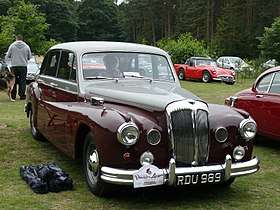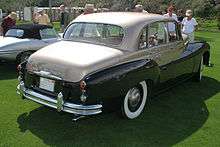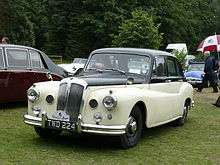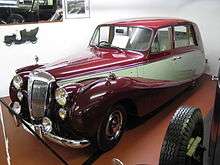Daimler Regency
The Daimler Regency series was a luxury car made in Coventry by The Daimler Company Limited between 1951 and 1958. Only 51 examples of the first Regency were made because demand for new cars collapsed just weeks after its introduction. Almost three years later in October 1954, a lengthened more powerful Regency Mark II (DF304) was announced but, in turn, after a production run of 345[3] cars, it was replaced by the very much faster, up-rated One-O-Four (DF310), announced in October 1955.
| Daimler Regency Series | |
|---|---|
 Regency Mark II 3½-litre 1955 DF304 with body by Barker | |
| Overview | |
| Manufacturer | The Daimler Company Limited |
| Production | 1951–1958 |
| Body and chassis | |
| Class | Luxury |
| Body style | Four-door saloon bodies by Barker or Empress body by Hooper or Special Sports DF302 convertible by Barker |
| Powertrain | |
| Engine | 2952, 3468 or 4617 cc inline six-cylinder |
| Transmission | 4-speed preselector gearbox with fluid flywheel |
| Dimensions | |
| Wheelbase | 114 in (2,896 mm)[1] |
| Length | 195 in (4,953 mm)[1] |
| Width | 70 in (1,778 mm)[1] |
| Height | 62.5 in (1,588 mm)[1] |
| Kerb weight | 2,000 kg (4,409 lb) |
| Chronology | |
| Predecessor | Daimler Consort (1949-53) |
| Successor | Daimler Majestic (1958-62) |
| 3-litre engine | |
|---|---|
| Overview | |
| Manufacturer | The Daimler Company Limited |
| Production | 1951-52 |
| Layout | |
| Configuration | 6-cylinder in-line |
| Displacement | 2,952 cc (180.1 cu in) |
| Cylinder bore | 76.2 mm (3.00 in) |
| Piston stroke | 107.95 mm (4.250 in) |
| Block material | Cast iron |
| Valvetrain | OHV pushrod cam-in-block |
| Combustion | |
| Fuel system | Twin S.U. carburettors |
| Fuel type | Petrol supplied by AC mechanical pump |
| Cooling system | Water pump and fan, thermostatically controlled |
| Output | |
| Power output | 90 bhp (67 kW; 91 PS) @ 4,100 rpm |
| Chronology | |
| Predecessor | 2-litre four-cylinder Lanchester Fourteen |
| Successor | 3½-litre and 4½-litre variants (211.6 cu in) and (281.7 cu in) |
| 3½-litre engine | |
|---|---|
| Overview | |
| Manufacturer | The Daimler Company Limited |
| Production | 1954-58 |
| Layout | |
| Configuration | 6-cylinder in-line[2] |
| Displacement | 3,468 cc (211.6 cu in)[2] |
| Cylinder bore | 82.5 mm (3.25 in)[2] |
| Piston stroke | 107.95 mm (4.250 in)[2] |
| Block material | Cast iron |
| Head material | Cast iron (Regency) Aluminium alloy (One-O-Four) |
| Valvetrain | OHV pushrod cam-in-block[2] |
| Compression ratio | 6.5:1 (Regency)[2] 7.6:1 (One-O-Four) |
| Combustion | |
| Fuel system | Twin S.U. horizontal carburettors[2] |
| Fuel type | Petrol supplied by AC mechanical pump[2] |
| Oil system | Submerged gear type pump, Tecalemit full-flow oil filter with safety by-pass[2] |
| Cooling system | Water pump and fan, thermostatically controlled[2] |
| Output | |
| Power output | 107 bhp (80 kW; 108 PS) @4,000 rpm (Regency)[2] 137 bhp (102 kW; 139 PS) @4,400 rpm (One-O-Four) |
| Chronology | |
| Predecessor | 3-litre Regency engine |
| Successor | 3.8-litre Daimler Majestic engine |
Regency DF300/1
Displayed to the press on 26 September and the following week at the Paris Motor Show, it was first shown to the British public at the October 1951 Motor Show.[4] The DF300 model designation was used for right-hand drive and DF301 for left-hand drive. The chassis included a number of new developments from the Daimler Consort which was still in production. The engine was moved well forward, the ground clearance increased by one inch and the chassis side members lowered. It was fitted with a new 3-litre 6 cylinder engine derived from the 4 cylinder 2-litre engine in the production Lanchester Fourteen. Twin SU carburettors were fitted to give 90 bhp at 4,100 rpm.[5]
The shape of the standard Barker saloon body closely resembled the much smaller Lanchester Fourteen, except that the headlights were fitted into the mudguards in the same position as the Daimler Consort. It was joined in 1952 by an Empress II saloon, limousine and convertible, all with razor-edge styling by Hooper.
Only a small number of Regency Barker Special Sports were made, perhaps three. They were externally distinguished by having front-hinged doors, not the "suicide doors" of the smaller-engined version. The usual Daimler Fluid Flywheel coupled the engine and its Wilson pre-selector 4-speed gearbox.
All new car sales collapsed in 1952 while the nation waited for the removal of a "temporarily" increased purchase tax, finally eased in April 1953. Including Empresses, an estimated 49 3-litre cars were produced[6] before production stopped.[7]
DF300/1 chassis numbers[6]
| Model | Numbers allocated | Notes |
|---|---|---|
| DF300/1 | 57000-57009 | Pre-production prototypes chassis number allocation. Two were Hooper Empresses. 57009 was not built.[6] |
| DF300/1 | 80000-80007 | Production 3-litre Regency standard steel saloon, except for 80002 which was an Empress. |
Of the DF300/1 chassis produced (excluding DF302/3), it is believed that only three have survived into the 21st century.[8]
| 57001 | A pre-production prototype converted to a pickup and used as a factory runaround. |
| 80002 | Built as a Hooper Empress. |
| 80005 | Standard production saloon. Formerly owned by HM the Queen Mother.[6] |
As per company policy at the time, pre-production chassis were either dismantled or retained as factory runarounds. [9]
DF302/3 - Empress Mk IIs and Coupes
A Hooper Empress Mark II was first exhibited at Earls Court in 1952 (chassis 82002). Hooper produced 33 examples, plus one on a standard 3-litre chassis (80002). Power was boosted to 100 bhp at 4,400 rpm by using an aluminium cylinder head and a higher 7.5 to 1 compression ratio.[10]
Note that Lady Docker's October 1953 Earls Court Motor Show car Silver Flash was listed in Hooper records as a 3-litre chassis, but with chassis number 85001. This was a Lanchester Fourteen chassis modified to fit a Daimler 6-cylinder engine.[11]
Chassis numbers[6]
| Model | Number | Notes |
|---|---|---|
| DF302 | 82000-82027 | Right-hand drive Hooper Empress Mark II, except for 82001 a coupe and 82008 a fixed-head coupe.[6] All Empress Mark IIs were six-light 4-door saloons, except for two four-light 2-door examples on chassis numbers 82006 and 82007[12]. |
| DF303 | 82400-82404 | Left-hand drive Hooper Empress Mark II. Four cars only as 82402 was not built.[6] |
It is thought that about half of all 3-litre Empresses Mk IIs survive.[6] Both 2-door examples survived into the 21st century.[13]
.jpg) Regency Empress by Hooper 1953 |
.jpg) |
Regency Mark II DF304/5
The revised Regency DF304 labelled Mark II was announced in October 1954. Left-hand-drive cars used the DF305 designation. The new more flowing body was slightly longer with a much longer boot and mudguards and was lower-set. It could now be purchased with a 3½-litre or 4½-litre engine. Again there was a Hooper version, the Empress IIa and III but now also the Sportsman four-light saloon with coachwork by Mulliners (Birmingham).[14] The (at first only) 4½-litre Sportsman with three-piece wrap-around rear window and extra interior luxury features was announced a few days later[15]
- Introductory pricing including tax: 3½-litre / 4½-litre engine
- Regency Mark II saloon: £2,324 / £2,778 with the new Tubeless Tyres fitted as standard equipment
- Regency Sportsman saloon: £2,650 / £3,104[16]
The revised chassis was again made of box section steel and was cruciform braced. The side members rose over the rear axle and were not underslung like the Consort. The suspension was independent at the front using coil springs but retained traditional leaf springs and live axle at the rear. Automatic chassis lubrication continued to be fitted, operating "thermostatically every time the engine warm(ed) up", and the propeller-shaft centre bearing was "prepacked with grease" so did not require lubrication.[17] However, the propeller shaft itself was not served by the system and four grease points required "attention every 1,000 miles".[17] Marles worm and double roller steering was used.[1] Brakes were Girling hydro-mechanical - hydraulic at front, mechanical to the rear - as was standard Daimler practice at that time on the Consort, Conquest and Lanchester Fourteen.
4½-litre chassis[18]
These examples had a chassis designation of DF400 (DF401 for LHD). The 4½-litre engine was offered as an option on the Regency Mark II chassis, but very few were fitted. The car differed from the 3½-litre DF304 in that a 4-speed pre-selector gearbox was fitted with direct drive in 3rd gear and an overdrive 4th gear. In addition, the DF304's Girling hydro-mechanical brakes were replaced with a fully hydraulic system with vacuum assist.[19] After an engine upgrade from 127 to 167 bhp in 1956, the increased torque proved to be too much for the pre-selector gearboxes, so very few 4½-litre cars survived. Plans for deliveries of further 4½-litre chassis were cancelled and most existing cars were recalled and converted to 3½-litre engines. Ultimately, the 4½-litre engine was restricted to the DK400 chassis.[20]
Performance
The British Motor magazine tested a 3468 cc Regency II saloon in 1955 recording a top speed of 82.8 mph (133.3 km/h) and acceleration from 0-60 mph (97 km/h) in 22.7 seconds and a fuel consumption of 15.7 miles per imperial gallon (18.0 L/100 km; 13.1 mpg‑US). The test car cost £2324 including taxes.[1]
Commercial
A spacious interior married with "an abundance of polished hardwood, not only for the facia but also for the door cappings, a floor .... covered with thick pile carpet" and the car's driving qualities will have attracted admiration, but purchase tax on cars was high and in 1954 the UK manufacturer-recommended retail price, including tax, for the standard bodied 3½-litre Daimler Regency was £2,324.[21] That price included a heater, but customers requiring a radio to be fitted would need to find another £48.[21] In the same year Jaguar's recommended UK retail price for the similarly sized (and very effectively promoted) Mark VII was £1,680.[22] (Jaguar buyers also received the heater included in the price, though they were obliged to find an extra £50 for a radio.) The price differential is probably enough to explain why relatively few Daimler Regencys found buyers but it should be pointed out that the Daimler was a much more substantial and durable product assembled with much greater care than Jaguars of that same day and aimed at quite different customers.

Chassis numbers[3]
The total chassis allocation was 395 units, but as noted not all may have been built. Standard production is thought to be 345 cars, allowing for chassis reallocation when some were fitted with the higher performance engine in late Regency Mark II production. 58 chassis were allocated for specialist coachwork, e.g. Hooper Empress Mark IIa and III. These incorporated a number of minor improvements over the DF304 chassis.[23]
| Model | Numbers allocated | Notes |
|---|---|---|
| DF304/5 | 88000-88010 | Prototype chassis allocation. |
| DF304/5 | 88250-88633 | Production 3½-litre standard steel saloon. It is believed that 39 numbers were reallocated to One-O-Four chassis numbers when the higher performance engine became available.[3] |
| DF306/7 | 91450-91474 | Upgraded chassis for Empress Mark IIa and other specialist coachwork.[24] |
| DF308/9 | 91475-91507 | Sportsman and Empress Mark III.[25] |
Replacing the Mark II
The Regency Mark II proved more successful than the first Regency, but after a short production run of only one year it was superseded in October 1955[26] by the 3½-litre One-O-Four (DF310) with a more powerful engine and various other upgrades.[27][28] While the top speed of the One-O-Four was tested at 102 mph compared to the Regency's 85 mph, the Regency actually had faster acceleration up to 50 mph. Standing quarter mile times for the One-O-Four were unchanged from the Regency. However when the automatic gearbox became available for the One-O-Four, the standing quarter mile was actually 2 full seconds slower than the Regency! [29]
Daimler One-O-Four
Announced in October 1955[26] the 3½-litre engine was given a new cylinder head and compression ratio of 7.6:1 generating almost 30% more power (137 bhp (102 kW; 139 PS) @ 4,400 rpm) to push the same 2-tonne Mk II to 104 m.p.h.[30] With upgraded brakes and interior, branded with a fluted boss bearing a large D in the centre of its back bumper, it was advertised as the 100 m.p.h. Daimler One-O-Four, when there were no open-road speed limits. The One-O-Four name refers to a prototype reaching the speed of 104 m.p.h. during testing. During 1956 a Borg-Warner fully automatic gearbox became available.[26] A One-O-Four Lady's Model was produced, finding only 49 customers. The special accessories in the Lady's Model inspired by Lady Docker became optional extras the following year. The One-O-Four was eventually replaced by the Daimler Majestic. When it first arrived in July 1958[31], the Majestic replaced the automatic One-O-Four. If customers wanted the pre-selector gearbox, they could still choose a One-O-Four. No more than 559 One-O-Fours of all models were produced before production ended in 1958. The car did not appear at the 1958 Earl's Court motor show.[32]
Chassis numbers[3]
| Model | Numbers allocated | Notes |
|---|---|---|
| DF310/1 | 88700-89057 | One-O-Four model. |
| DF310/1 | 90000-90016 | One-O-Four model. |
| DF310/1 | 96850-96898 | One-O-Four Lady's Model. |
| DF314/5 | 90100-90234 | One-O-Four with automatic transmission. |
One-O-Four Upgrades
Numerous upgrades to the Regency Mark II were incorporated into the Daimler One-O-Four. The following is a summary of the major changes. In addition, many minor changes were introduced.[33]
| Part or assembly | Notes |
|---|---|
| Engine | Aluminium alloy cylinder head. Compression ratio increased from 6.5 to 7.6. Quick-lift camshaft. Diaphragm type SU carburettors. Power raised from 107 bhp (80 kW; 108 PS)@4,000 rpm to 137 bhp (102 kW; 139 PS)@4,400 rpm. |
| Gearbox | A fully automatic Borg-Warner gearbox option became available in the autumn (fall) of 1956.[34] |
| Brakes | Fully hydraulic brakes with vacuum assist replaced hydro-mechanical brakes. |
| Hand brake | On floor between door and driver's seat. |
| Steering box | The Regency's Marles steering box was replaced by a Burman unit.[33] |
| Rear axle | Ratio raised from 4.3 to 3.92 or optionally 3.64. |
| Hub caps | Flatter hub caps fitted replacing the Consort style ones on the Regency. |
| Body | Cast A and B door pillars replaced by pressed steel sections. |
| Windows | Electric window option available.[33] |
| Trafficators | The Regency Mark II's turn signals controlled by a flasher unit were replaced with Trafficators in the body B pillar, except for DF311 USA imports.[33] |
 One-O-Four 3½-litre |
 Sportsman 3½-litre |
 Sportsman 3½-litre |
.jpg) Empress 3½-litre |
.jpg) Empress 3½-litre |
 Empress Mk II |
References
- Citations
- "The 3.5-litre Daimler Regency Mk II Saloon". The Motor. January 19, 1955.
- Road Test No. 3/55 (Continental) The Motor Temple Press, London 1955
- The Daimler Tradition, Brian E. Smith 1972, p. 201.
- The Motor Show.The Times, Wednesday, Oct 17, 1951; pg. 4; Issue 52134
- The Daimler Tradition, Brian E. Smith 1972, pp. 189-191.
- Daimler Days, Part Four 1953, Brian E. Smith, 1996, p.757-758
- Daimler Car Cheaper Until Budget Day; Production of the new 3-litre model has been postponed until after the Budget.The Times, Tuesday, Feb 03, 1953; pg. 3; Issue 52536.
- A Unique Passion - Regency 3-Litre by Milo Kelly and Dave Philpot. The Driving Member, Dec/Jan 2012/2013; pg. 32-35; Volume 49 Number 7.
- A Unique Passion - Regency 3-Litre by Milo Kelly and Dave Philpot. The Driving Member, Dec/Jan 2012/2013; pg. 32-35; Volume 49 Number 7.
- The Daimler Tradition, Brian E. Smith 1972, pp. 195-196.
- The Driving Member, April 2009; pg. 8; Volume 45 Number 10.
- The Driving Member, June 2012; pg. 2; Volume 49 Number 1.
- The Driving Member, June 2012; pg. 2; Volume 49 Number 1.
- New Big Daimler Models. "The Motor" Vol 106, October 6, 1954
- Display advertisement, Daimler. The Times, Monday, Oct 04, 1954; pg. 5; Issue 53053.
- New Daimler Models. The Times, Thursday, Sep 30, 1954; pg. 3; Issue 53050
- "Daimler Regency Mark II 3½-litre". Autocar. October 1, 1954.
To reduce the need for maintenance, automatic chassis lubrication is provided thermostatically every time the engine warms up. The propeller-shaft is not served by this system, and four points require attention every 1,000 miles (1609 km). The propeller-shaft bearing, however, is prepacked with grease and does not require lubrication.
- The Daimler Tradition, Brian E. Smith (1972), chapter 8
- The Daimler Tradition, Brian E. Smith 1972, p. 245.
- The Daimler Tradition, Brian E. Smith 1972, pp. 247-248.
- "Daimler Regency Mark II 3½-litre". Autocar. October 1, 1954.
- "Jaguar Mark VII saloon (with overdrive) (road test)". Autocar. January 15, 1954.
- Daimler 3½-litre Range Service Parts Catalogue
- The Daimler & Lanchester Owner's Companion, R. I. Whyte (1981)
- The Daimler & Lanchester Owner's Companion, R. I. Whyte (1981)
- Details of a new Daimler were announced yesterday. The Times, Friday, Oct 14, 1955; pg. 4; Issue 53351
- Douglas-Scott-Montagu & Burgess-Wise 1995, p. 269.
- New Standard Vanguard.The Times, Friday, Oct 14, 1955; pg. 4; Issue 53351
- Comparison of The Autocar road tests for the Regency Mk 2 (January 1955), One-O-Four Ladies Model (October 1955), One-O-Four Automatic (April 1957)
- High Performance As Part Of The Daimler Tradition. The Times, Tuesday, Jul 10, 1956; pg. 5; Issue 53579.
- The Autocar, New Cars Described, July 4, 1958
- Daimler Days, Part Four 1958, Brian E. Smith, 1996, p.818-819
- Service Parts Catalogue for the Daimler 3½-litre Range (1st ed.). Coventry: Daimler Company Ltd. 1956.
- The Daimler Tradition, Brian E. Smith 1972, pp. 210-211.
- Sources
- Douglas-Scott-Montagu, Edward John Barrington & Burgess-Wise, David (1995). Daimler Century: The full history of Britain's oldest car maker. Sparkford, Nr Yeovil, Somerset, UK: Patrick Stephens. ISBN 1 85260 494 8.CS1 maint: ref=harv (link)
- Smith, Brian E. (1972). The Daimler Tradition. Isleworth, UK: Transport Bookman. ISBN 0851840043.CS1 maint: ref=harv (link)
External links
- Standard saloon by Barker. Announcement, company internal news item October 1951
- Special Sports fixed head coupé by Barker DF302
- Regency DF304 Mark II
- Empress II saloon by Hooper
- Sportsman saloon by Barker, 4½-litre
- Silver Flash for Lady Docker